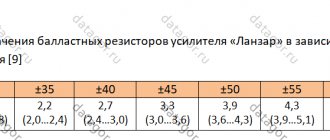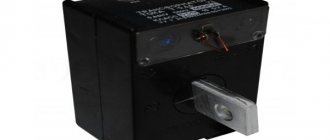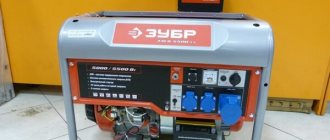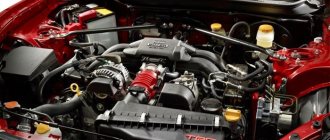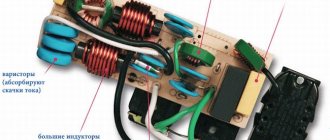- November 27, 2019
- Tools and equipment
- Gennady Rostov
Uninterrupted electricity is an unattainable ideal. Difficulties in supply arise due to natural anomalies, wear and tear of equipment, and broken transmission lines. The solution to this problem is an autonomous energy source. All that remains is to decide which generator to choose for your home and how to calculate the power required to operate electrical appliances.
General characteristics of electric generators
You can determine which autonomous source of electricity to choose based on its characteristics.
Type of use:
- basic;
- spare;
- emergency.
Location:
- in room;
- in a special casing;
- outdoors in an open area.
Unit type:
- petrol;
- diesel;
- gas.
Control type:
- auto;
- starter;
- manual start.
Number of phases:
- three-phase;
- single-phase.
Type of cooling:
- air;
- liquid.
To decide how to calculate the power of a generator for a home, you need to select the sum of the energy capacities of the devices used, taking into account the starting currents. If you make the wrong choice, the unit will operate at maximum capacity, consume excess fuel and fail prematurely.
How to choose a generator according to power for your home
Minimum energy consumption is the sum in watts of the rating data of household appliances, taking into account inrush currents. To operate the unit, a reserve is needed, so the resulting value increases by 20%. Calculating generator power for a home begins with determining permanent connection devices. Next, information on periodically used devices is added to the calculation, and the required power of the mobile station is obtained. Information on the nominal and starting energy consumption of devices and tools is presented in the table.
| Name | power, kWt | Starting power, kW |
| Video recorder | 0,1 | 0,11 |
| Columns | 0,03 | 0,033 |
| Coffee maker | 1,2 | 1,8 |
| Incandescent lamp | 0,1 | 0,1 |
| Microwave | 1 | 2 |
| Energy saving lamp | 0,012 | 0,012 |
| Mixer | 0,3 | 0,45 |
| Freezer | 0,7 | 2,1 |
| Music Center | 0,2 | 0,22 |
| Laptop | 0,05 | 0,055 |
| Heater | 1,5 | 1,65 |
| Personal Computer | 0,4 | 0,44 |
| Dishwasher | 1,5 | 2,25 |
| Printer | 0,35 | 0,385 |
| Vacuum cleaner | 1,5 | 1,65 |
| Washing machine | 4 | 6 |
| Phone charging | 0,025 | 0,025 |
| Iron | 1 | 1,1 |
| Iron with steamer | 1,25 | 1,375 |
| Hairdryer | 1 | 1,1 |
| Fridge | 0,2 | 0,6 |
| TV | 0,25 | 0,275 |
| Sewing machine | 0,1 | 0,11 |
| Electric shaver | 0,02 | 0,022 |
| Electric kettle | 2,5 | 2,75 |
| Concrete mixer | 1,32 | 3,96 |
| Electric drill | 0,5 | 0,75 |
| Compressor | 2,2 | 6,6 |
| Brush cutter | 0,5 | 0,75 |
| Belt Sanding Machine | 1 | 3 |
| Electric jigsaw | 0,4 | 0,6 |
| Lawnmower | 1 | 1,5 |
| High pressure washer | 3,5 | 10,5 |
| Emery | 0,4 | 0,6 |
| Heating pump | 0,1 | 0,3 |
| Sprayer | 0,6 | 0,9 |
| Jackhammer | 3 | 9 |
| Hammer | 0,7 | 1,05 |
| Submersible pump | 1,5 | 4,5 |
| Spotlight | 0,5 | 0,55 |
| Electric planer | 0,7 | 1,05 |
| Trimmer | 0,5 | 1,5 |
| Welding transformer | 3,5 | 14 |
| Chain Saw | 1,5 | 2,25 |
| Cycling machine | 2 | 3 |
| A circular saw | 1 | 1,5 |
| Sander | 0,175 | 0,2625 |
| Grinding machine | 0,45 | 0,675 |
| Electric stove | 1,2 | 1,32 |
Let's look at how to calculate the power of a generator for a private home.
Always on household appliances:
- fridge;
- freezer;
- lighting from 10 energy-saving lamps;
- computer;
- TV;
- heating system pump.
Periodic use devices:
- microwave oven;
- washing machine;
- vacuum cleaner;
- Dishwasher;
- iron;
- electric kettle.
Sum of equipment capacities from the first list:
0.6 + 2.1 + 0.12 + 0.44 + 0.275 + 0.3 = 3.835 kW.
To operate the generator, you need to increase the obtained value by 20%:
3.835 × 1.2 = 4.602 kW. For constantly switched on devices, a 5 kW unit is sufficient.
The sum of the capacities of household appliances from both lists, increased by 20%:
(3.835 + 2.0 + 2.25 + 6.0 + 1.65 + 1.1 + 2.75) × 1.2 = 23.502 kW. Thus, the power of a gasoline generator for a home, without restrictions on the use of electrical appliances, requires at least 23.5 kW.
How to choose a generator?
In this article, we have collected all the necessary minimum knowledge about generators, which will allow you not to make a mistake when choosing one.
Before you start choosing a generator, you should clearly decide which parameters are most preferable to you. When purchasing a device, you need to take into account its weight, dimensions, operating time, automation, noise level, fuel consumption, power and, of course, price.
How many phases should a generator have?
In order to answer this question, it is necessary to understand which consumers will be connected to the electric generator. Only single-phase consumers can be connected to a single-phase power plant. Both single-phase and three-phase can be connected to a three-phase power plant. But this property does not mean that three-phase power plants are always better. It must be remembered that for most generators the maximum permissible load on each phase should not exceed 30%. In practice, this means that you cannot remove more than one-third of the rated power from a single-phase socket of a three-phase generator. Those. if a three-phase generator has a rated power of 6 kW, then you can remove no more than 2 kW from a 220 V outlet. In addition, when connecting consumers to three-phase power plants, it is necessary to achieve uniform distribution of loads across phases.
As a result, it is best to take a three-phase station only when you have a three-phase consumer. If all consumers are single-phase, then in the vast majority of cases it is worth choosing a single-phase generator.
How to calculate the required generator power?
Power is one of the main parameters that need to be taken into account when choosing a generator. To determine the required power of the electric generator, you should check the power of the devices that will be connected to it. It must be taken into account that the power of the electric generator must exceed the sum of the powers of all simultaneously connected devices that will operate for more than five minutes by 20-30%. This is due to the fact that the power plant will operate in the most optimal mode only when the load connected to it does not exceed 40-80% of the rated power.
If the generator power is selected incorrectly, then you are likely to encounter:
- overloading the generator and its subsequent shutdown;
- reduced service life due to prolonged operation at extreme conditions;
- high fuel consumption.
By selecting the power correctly, you will be able to connect previously unforeseen consumers to the network powered by the power plant.
Watts, volt-amps and power factor
Please note that power can be measured in watts (W) and volt-amperes (VA). If the instructions for the device and the instructions for the generator indicate power in different dimensions, then it is worth converting both values to a common unit of measurement. To convert kVA to kW, the value in volt-amperes must be multiplied by the power factor (cos ȹ).
Let's say we have a power plant with a capacity of 3 kVA and a power factor of 0.8; Having made simple calculations by multiplying 3 by 0.8, we find out that the power of this installation is 2.4 kW. Now let’s calculate what power vacuum cleaner can be connected to it. Typically (cos ȹ) of a vacuum cleaner is approximately 0.5. In total, let’s calculate the power of the vacuum cleaner: 3 × 0.8 × 05 = 1.2 kW.
What should be the power of a heater that can be connected to the power plant described above? Since the heater has no reactivity, its power factor is equal to the same. Let's multiply: 3 kVA × 0.8 × 1 = 2.4 kW. That is, the power of the heater is the same as the power of the power plant itself.
Resistive, inductive, capacitive...
To correctly select a generator, it is important to know the resistive, inductive or capacitive devices you are going to use. Resistive devices consume current with active power, simply those that do not have an electric motor. These include heating appliances, incandescent lamps, and stoves. For this type of device, any generator of appropriate power is suitable, since they completely convert the consumed power into light or heat.
Inductive devices are devices that are powered by an electric motor. For example, a compressor, pump or sawmill. This type is characterized by power loss due to winding friction, so only 70% of the original value is used as useful power. Also, in inductive devices, additional power is required to start the motor. Therefore, when working with such devices, it is better to have a generator power reserve of about 20%.
If you purchase a power station to connect inductive devices to it, you should definitely find out what maximum current it can withstand.
Capacitive devices are the most sensitive current consumers (for example, professional discharge lamps, flash lamps). To work with such devices, exclusively asynchronous generators are used.
Starting current
Inrush current is the current that occurs for a short period of time after starting equipment equipped with an electric motor. The starting current can be several times higher than the rated power of the unit. The value of this current can be found in the device data sheet. For approximate calculations, you can use the following table:
| TV | 1 | Electric planer | 2 |
| Kitchen stove | 1 | Angle grinder (grinder) | 2 |
| Coffee maker | 1 | Grinder | 2 |
| Heater | 1,2 | Electric saw | 2 |
| Incandescent lamps | 1 | Drill | 3 |
| Vacuum cleaner | 1,2 | Boiler, boiler (Boiler) | 3,4 |
| Microwave | 2 | Concrete mixer | 3,5 |
| Washing machine | 3,5 | Hammer | 3 |
| Computer | 2 | Air conditioner | 3,5 |
| Fridge | 3,3 | Submersible pump | 7 |
| Freezer | 3,5 | Electric meat grinder | 7 |
| A little trick - if you connect the equipment not directly to the generator, but through a fairly thick and long extension cord wound into a coil (you need to wind the wire in turns, say, on a stick), then in this case the extension cord behaves like a choke (an inductor with a high AC resistance current) and starting currents at the generator input are significantly reduced. |
How to choose the right power?
Thus, when choosing a generator you need:
- determine what devices you will connect to the generator;
- determine the power of these devices (usually this can be read in the instructions or on the devices themselves);
- know the inrush current coefficients for these devices;
- Based on the type of device and its power, calculate the required power of the unit.
If you cannot find out exactly what power the devices you are going to connect are, use the following table of approximate values:
| Fridge | 0.1-0.3 kW | Microwave | 1 kW |
| TV | 0.08 kW | Electric kettle | 2 kW |
| Washing machine | 1.5 kW | Vacuum cleaner | 0.8 kW |
| Iron | 1 kW | Incandescent lamps | 0.04-0.1 kW |
| LCD monitor | 0.02-0.06 kW | CRT Monitor | 0.07-0.2 kW |
A simple example of calculating generator power
We need a backup generator for the dacha, so that when the lights are turned off for a couple of days again, the refrigerator does not turn into a foul-smelling box for vegetables and meat, and in the dark you can walk around the rooms without fear of injury. It would also be great to watch TV and vacuum the floor sometimes.
The total power of the devices we have listed will be approximately 1.5-2 kW. Let's look at the type of load placed on the power source (generator). To do this, let's look at the table of starting currents, and after that we will calculate the required power for the simultaneously connected consumers of electricity listed above (take the maximum values): 0.3 kW × 3.3 + 0.2 kW (two 100 W lamps) × 1 + 0.08 kW × 1 + 0.8 kW × 1.2 = 2.23 kW . And because Usually the maximum power of a generator (the power it can produce for a short period of time) usually exceeds its rated power, for our purposes we can easily take a 2 kW generator.
Fuel consumption
Do you need to determine the fuel consumption of a power plant? You need to know the power of the generator in kW. Consumption in g/kW*hour multiplied by the generator power in kW gives consumption in g/hour. To get in liters/hour you need to know the specific density of the fuel in g/liter (for AI-95 (A-95) approximately 750 g/liter, for diesel fuel 840 g/liter), i.e., divide the consumption in g/hour by density in g/liter. For example, gasoline consumption is 350 g/kW*hour. Generator power 5 kW. Those. fuel consumption at full power - 350x5=1750 g/hour. We divide the resulting amount by the density of gasoline (in our case AI-95) 750 g/liter and we get 2.3 l/hour.
When accurately calculating consumption, it is also worth taking into account the change in fuel density when the external temperature changes. The tabulated fuel density is indicated at nominal temperature (20 degrees Celsius). The lower the temperature, the lower the density.
Synchronous and asynchronous generators
Synchronous generators have a lower current quality compared to asynchronous ones, but, nevertheless, they are suitable for emergency power supply of offices, refrigeration units, equipment of country houses, summer cottages, and construction sites. Such generators are more resistant to short-term overloads, but are poorly protected from water, dust and dirt since they draw air through them for cooling. The main advantage of such electric generators is that they handle peak loads relatively painlessly. Those. To operate devices with a reactive load (having an electric motor), you will need a generator of lower power (compared to an asynchronous one).
Asynchronous generators do not tolerate peak loads well, but they ensure that the voltage in the network is maintained with high accuracy, so they allow you to connect equipment that is sensitive to voltage surges (for example, medical equipment, computers, other electronic devices). The source of electric current in them is the residual magnetization of the rotor. Thanks to this principle, asynchronous generators are more durable: they do not require air cooling and their housing is completely closed and protected from moisture and dust. Due to their immunity to short circuits, such generators are an ideal power source for welding machines. But they are sensitive to overloads and are not suitable for powering power tools and other devices with high inrush currents.
What kind of engine do you need?
The engine is the main part of the unit; how long the power plant will last depends on its potential. Engines are petrol, diesel and gas. The service life of an air-cooled generator with a gasoline engine is approximately 500-800 operating hours for a Chinese gasoline engine, up to 2,000 thousand operating hours for Honda, Briggs & Stratton or Kohler engines. The service life of diesel engines significantly exceeds this figure and ranges from 2500 operating hours for an air-cooled engine and 3000 rpm to 20,000-30,000 for liquid-cooled engines and 1500 rpm. The service life of gas engines is much longer than that of gasoline engines and approximately the same as that of diesel engines. The service life of an air-cooled gas engine is 1500-2000 operating hours for Chinese engines and about 3000-4000 thousand for Japanese, European and American engines. As for liquid-cooled engines, their service life starts from 10,000 operating hours for small displacement engines, up to 40,000-50,000 operating hours for large displacement engines.
Gasoline engines are usually used on medium and low power generators. Cheap generator, low resource. This is a great option if you rarely lose power. Diesel engines are used for backup power supply of medium and high power. Quite an expensive generator with a good resource. Most often used in construction or reserve of large objects. Gas-fired ones are ideal for backup power supply to homes and industries. Gas generators are more expensive than gasoline generators and cost about the same as diesel ones. But unlike both, they have serious advantages: if there is a main gas pipeline, the cost of 1 kW/h will be cheaper than that of gasoline and diesel engines, which means that during intensive use the generator will pay for itself much faster. In addition, for liquid-cooled gas generators, the cost of 1 kW/h (taking into account the cost of the station and the cost of its maintenance) is always lower than the cost of 1 kW/h from the city network. On average, this is from 1.5 to 3 rubles per 1 kW/h. And this is not to mention the fact that the gas engine is noticeably more environmentally friendly than both gasoline and diesel engines. For example, when working on methane, the smell of exhaust gases is practically not felt, and this is important for a country house.
| Cost of fuel to produce 5kW in 1000 hours | |
| Petrol | RUB 128,047 |
| Diesel | RUB 79,674 |
| Propane-butane (cylinder) | RUB 49,756 |
| Methane (main) | RUB 12,764 |
Operating mode
Correctly determining the operating mode of the generator will allow you to use its resource most efficiently.
| ENGINE'S TYPE | MOTORRESURS | ADVANTAGES | MODE OF USE |
| Gasoline engines, air-cooled, 3000 rpm | 700-2000 m/h | Lowest cost watt/ruble ratio. Low noise and vibration levels. | Backup or emergency source of power supply, when operating up to 100 hours per year. Or as a permanent source for a period of up to 2 months. |
| Air-cooled diesel engines, 3000 rpm | 2500-3000 m/h | Twice the lifespan of air-cooled gasoline engines. Low response to load changes. Reliable launch. | Emergency power supply for use in places where there is no gasoline or for emergency work. |
| Liquid cooled diesel engines, 3000 rpm | 7000-10000 m/h | Quickly warm up the engine before connecting the load. Reliable launch. | Backup source of energy supply, during operation up to 1000 hours per year. Or as a permanent source for a period of up to 6-9 months. |
| Liquid cooled diesel engines, 1500 rpm | 15000-20000 m/h | High motor potential. Economical. Low noise and vibration levels. reliable start. | A backup and permanent source of supply for a long time (about 10 and 2 years, respectively). |
| Air-cooled gas engines, 3000 rpm | 1500-4000 m/h | High engine life, quick engine warm-up. Low cost kW/h. | Backup source of power supply with low cost kW/h. |
| Gas engines, liquid cooled, 1500 rpm | 10000-40000 m/h | High motor potential. The cost of 1 kWh is lower than that of the main network. | Backup or permanent source of power supply. With constant operation, the payback period is from 7 to 15 months. |
All data presented in the table are approximate and do not apply to a specific power plant.
Fuel safety It is important to remember that long-term storage of gasoline (more than 6 months) deteriorates its properties, which can lead to loss of power or even engine failure. Don't forget to change it every 3-4 months if you don't use a generator. Diesel fuel is more resistant to long-term storage. Generator for a summer residence
Which generator to choose for your dacha? First of all, you need to decide how much total power the appliances in your home consume. Above we calculated the minimum required power, for an “average” country house - 2 kW. But you don’t want to have to calculate watts every time, and even if limiting yourself, still use all the main electrical appliances at home. In practice, for a house inhabited by 4 people, the optimal generator power is 4-5 kW. It will be enough for basic household appliances at home (you may even forget that in the entire holiday village, no one except you has electricity).
What is better, save money and take a device from China, or still shell out the required amount and buy a generator made in Europe/Japan? The answer is not as obvious as it might seem at first glance. First of all, it depends on how often the generator will operate. The engine life of a modern Chinese-made generator is 1-1.5 thousand hours. If the electricity is turned off a couple of times a month for 6 hours, then you yourself can easily calculate that with such intensity of operation, the resource will last for 15 years. If a budget generator can easily meet your needs for the foreseeable years, is it worth overpaying for a better one ( and therefore an expensive) brand? It's up to you to decide, but I don't think there's much point.
When is it wrong to save money on a generator? First of all, when you plan to use it extremely intensively. For example, electricity is supplied only periodically and the generator will run for several hours every day. In this case, the quality of the generator and the reliability of its operation fully pay for the money spent on it.
Generator for welding machine
The correct selection of a generator for a welding machine must take into account a huge number of different data, such as the maximum welding current, power, current curve, etc. of welding machines. The starting currents of the welding machine are so aggressive and instantaneous that the generator fuses do not have time to melt and the alternator burns out. For simplicity and reliability, the generator power should be chosen three times greater than the power of the welding machine. There is also a second way. Before connecting the welding machine to the generator, turn the welding current to a minimum and only then connect it to the generator. It is worth considering that a 5 kW generator is ready to withstand welding current within 160A. Increasing the current above this value increases the likelihood of generator failure.
Price-quality ratio
Planning a major purchase always involves looking for the best value for money. Today, electric generators produced in countries such as France, Germany, the USA and Japan (SDMO, Endress, Generac) are famous for their high-quality units, a good assortment, the highest quality, but not very affordable prices. This is high quality and reliable equipment. But don't discount generators made in China. Some brands are very close in quality and reliability to their European/Japanese/American counterparts (for example, Ergomax, Kipor, Huter), and the price is two to three times cheaper. There are also brands that are between these two categories - for example, the Russian-Chinese TCC or the German-Chinese Fubag. European production culture and high-quality components make their products the best in their class. Among the gas generators, in addition to Generac, one can highlight the Russian-made Gazvolt generators. A distinctive feature of these generators is that they were originally designed for Russian operating conditions - all generators in the database are equipped with a set for winter operation, which allows for reliable starting at low temperatures (and this is especially important for gas engines), and are also configured for Russian gas.
If we talk about specialization, it is better if it is a company that is exclusively engaged in the production of generator sets. Since this type of business is highly specialized, do not count on finding a company name that everyone knows. It is also worth considering that low-power units produced by branded companies can be unreasonably expensive. Make sure that the company producing the generators has quality certificates and its products meet international standards.
Before you buy an electric generator, think about how competent you are in this matter. If you are tormented by doubts, it is better to seek help from a specialist. If you know exactly what you want, have taken into account the device parameters you need, have studied the market and decided on the price, do not forget to think in advance about possible repairs and carefully check the warranty documents when purchasing.
Example of a generator room
Gasoline generator
The device uses AI-92 as fuel. The operating life of a single-cylinder design without failure is from 2500 to 4000 hours and a two-cylinder design is more than 5000 hours. The power of units with a four-stroke engine is from 1 to 15 kW. The generator is used during emergency power outages for up to 8 hours. Despite the loss in durability and reliability compared to units using other types of fuel, the demand for gas generators is good due to the low price.
Generator advantages:
- small dimensions;
- reduced noise level;
- readily available fuel;
- startup and operation at negative temperatures;
- simple maintenance;
- low price.
Disadvantages of the device:
- high cost of electricity;
- gasoline decomposition when stored for more than 6 months;
- overheating during long hours of operation.
The synchronous type gasoline generator engine allows you to maintain the quality of the current under loads. The fuel tank capacity of 10 to 25 liters allows the unit to operate for up to 12 hours without refueling. Overload and short circuit protection extends service life before failure.
So, which generator to choose for emergency power supply? The decision must be made taking into account the following points:
- place of use;
- power calculation;
- manufacturer selection;
- familiarization with technical characteristics;
- studying reviews from device users to select the final option.
Examples of gas generator models:
- Inverter-type devices have a stable current frequency and voltage, which is suitable for powering sensitive devices. The device can operate at half the installed power. Example - HAMMER GN800 generator, runs on a mixture of gasoline and oil in a ratio of 1 to 50, weighs 18 kg. The device is suitable for going out into nature or powering a trade tent for 6 hours on one refill.
- A unit with a synchronous alternator copes with peak loads 1.65 times higher than the nominal value and is suitable for emergency power supply of household appliances and tools. Example - PATRIOT Max Power 5.5 kW generator, runs on AI-92 gasoline, weighs 66 kg, supports powering devices with electricity for 8 hours.
- The EUROPOWER gasoline generator with a rated power of 14.5 kW is a mode in which the station operates without excess load. For single-phase devices the coefficient is indicated - 1.0, three-phase - 0.8. The unit is suitable for power supply to a cottage or store; the operating time before refueling is 10 hours. Requires periodic shutdown for cooling.
Synchronous, asynchronous, inverter types of generators
- Synchronous. The generated current is ripple-free, the models tolerate peak loads well. Suitable for powering devices requiring high starting currents;
- Asynchronous. Cheaper than synchronous ones, but do not cope well with peak loads. The simple design protects them from short circuits. Suitable for energy-intensive equipment;
- Inverter. Characterized by high quality generated current, they are suitable for powering noise-sensitive industrial and consumer electronics.
Diesel generator
The station operates without stopping for a long time and is used as a backup or main source of electricity. The service life of diesel units with liquid cooling is up to 40,000 hours. How to choose a generator for your home and calculate the power is determined taking into account the starting currents of household appliances and tools. For units with an asynchronous motor, the quality of the current decreases under load. This characteristic is taken into account when calculating the power of a generator for a home.
Advantages of the device:
- long work without a break;
- low fuel consumption;
- versatility of use;
- easy maintenance.
Disadvantages of diesel generators:
- at negative temperatures, heating is required;
- increased noise during operation of the unit;
- a constant load of at least 30% of the rated power is required;
- diesel fuel quality requirements;
- cost of the unit.
The scope of use of generators is from private households to construction sites. An economical and reliable diesel station as a source of electricity.
Characteristics of diesel generator models:
- An example of a backup type unit is FUBAG DS 3.0 kW, suitable for periodic work with power tools and for lighting up to 9 hours in a row. The device has handles and wheels for transportation. The 12.5 liter fuel tank reduces the full load weight to 67 kg. The fuel consumption of the unit is two times lower than that of a gas generator.
- Diesel generator CTG AD-42RES 30 kW, voltage - 380 V. The device can power up to three devices in single-phase mode at a third of the power - 10 kW, three-phase equipment - 30 kW. One filling of diesel fuel is enough for 12 hours of continuous operation. The unit has a noise-proof casing and water cooling, and supports automatic switching on during power outages.
Gas generator
The gas generator uses liquefied or pipeline gas as fuel. Connecting the unit to the main line and servicing during operation is associated with material costs for approval and operation of the gas service. Calculation of power as for diesel and gasoline units, taking into account the energy consumption of the devices used.
Advantages of the gas generator:
- fuel cost;
- no toxic exhaust;
- performance;
- low noise level;
- reliable operation.
Flaws:
- dependence on uninterrupted gas supply;
- installation and maintenance costs;
- placement in a heated place;
The power of gas generators is from 1.5 to 3 thousand kW. Units less than 6 kW have air cooling, while high-capacity stations have water cooling. These units are beneficial when there is a stable main gas supply.
An example of a GREENGEAR GE 5 kW unit model for backup electricity supply, runs on gas, both main and liquefied. The noise level is 65 decibels, which is the same level as human speech. The device has an asynchronous alternator, which maintains the accuracy of the output voltage. This is required for connecting sensitive electronic devices and motors.
Generator drawing
Since we have 12 magnets on the disks, then 360:12 = 30, it turns out that the sectors for the magnets are divided by 30 degrees. We have 18 coils, so 360:18 = 20, that is, a 20-degree sector of the coil. A coil should fit in a 20 degree sector, the winding width is 10mm, and the thickness of the stator is 8mm, which means wires with a diameter of 1mm will fit 10*8:1=80 turns. If you wind it with 1.5mm wire, then 10*8:1.5=53 turns will fit. And if the wire diameter is 2mm, then accordingly 80*8*2=40 turns.
Welding generator
To carry out welding work in the absence of a network connection to electricity, special models of gasoline and diesel mobile stations are used. These units can withstand starting welding currents.
Device advantages:
- installation anywhere;
- resistance to loads;
- use for connecting devices and tools.
Negative characteristics:
- small resource of work;
- inability to simultaneously connect welding and other tools;
- noise level.
How much power a generator needs is determined by the welding current required for the work.
An example of a gasoline welding unit with a rated power of 5 kW is FUBAG WS 230 DC ES. The device has manual and electric start, output current 230 A, electrode diameter from 1.6 to 5 mm. The generator allows welding work to be carried out for 9 hours on one fuel fill.
Generator control type
Electric generators are equipped with one of three types of control or a combined system. A simple way is to start manually, which requires physical effort and skill. Generators of all types with power up to 7 kW are equipped this way. The advantages of manual control are low price and reliability.
Units with a power above 7 kW usually have a starter type of start, combined with manual control. The device is started by pressing a button or turning the key. The starter is powered by a battery. Such a start is more expensive than a manual one, but the unit is controlled without physical effort.
Automatic control starts the generator when there is a power outage and provides power to household appliances and security systems even in the absence of the owners of the house. Installing equipment on low-power gasoline and diesel generators is unprofitable due to the high price. After the main supply is restored, the automation will automatically turn off the unit. The disadvantages, besides the cost of installing the system, is the need to install an electrical station in the room, otherwise the autostart does not work.
An example of calculating generator power for a summer residence
In this example, we calculate how much power a generator is needed for a country house in a remote area that does not have a connection to the main power grid. Water comes from a well on the site. Before choosing a generator for your home and calculating the power, a list of electrical appliances that are necessary for comfort is compiled.
List of household appliances taking into account starting currents, power in kW:
- interior lighting - 0.5;
- street spotlight - 0.5;
- submersible pump - 3.0;
- air conditioner - 1.5;
- instantaneous water heater - 1.2;
- refrigerator - 0.6;
- TV - 0.275;
Appliances for periodic use, power in kW:
- microwave oven - 2.0;
- electric kettle—2.2;
- laptop - 0.055;
- vacuum cleaner - 1.65;
- phone charger - 0.025;
- drill - 0.75;
- electric saw - 1.5;
The calculation takes into account that 80% of the maximum generator power is used. The amount of energy consumption of devices for constant use in the country is 7.575 kW. It is reasonable to use the rest of the household appliances in turn. Of the listed devices, the most powerful is an electric kettle. Final value: (7.575 + 2.2) / 0.8 = 12.22 kW. It remains to determine what power generator to take for your home.
The cottage is intended for seasonal living, so a mobile station capable of long-term operation without stopping is required. Diesel or gas units are suitable for this. The TSS AD-12S electric generator, with water cooling and an operating time of up to 20 hours, is suitable for the given power. Tank volume is 54 liters, average fuel consumption is 2.5 l/hour. Rated power - 12 kW, peak - 15 kW.
As an alternative option for power supply to a dacha farm, the FAS-13 unit, which runs on liquefied gas, is suitable. The model of the engine used is VAZ 21067, water-cooled, has an automatic start function. The maximum power is 13 kW with a gas consumption of 0.45 m3/hour; a 50-liter cylinder is enough for a day of continuous operation of the unit.
Is it better to choose a single or three-phase generator for a private home?
Perhaps the answer is obvious to many. However, there are several nuances.
Actually, the choice of a three or single-phase generator is mostly determined by the layout of the electrical wiring in the house. If the circuit is three-phase, then a three-phase generator will suit you just fine (but not all generators; I’ll explain why later in the text). If the house is connected to a single-phase network, then there is no need to rack your brains here - take a single-phase one.
So, if you have a single-phase network, then the choice is obvious and for a backup power supply it is enough to consider a power of 3 kW (further calculations why this power is needed). With three phases, this option is allowed with a reservation. The thing is that three-phase generators produce the declared power only in all phases. Those. for distributed three-phase load. Whereas if one phase is overloaded, the generator will turn off the load.
Example: a 6 kW generator produces the declared power only when the same current passes through all three phases. Those. 16 amps per phase.
Now let’s imagine that according to your load distribution scheme, the kitchen lighting, as well as all the sockets in this room, “hangs” on phase “A”. Your lights are on, your TV and computer are working. You turn on the kettle and the generator begins to twitch nervously due to overload in one phase. If the current in this phase exceeds the maximum (16 A), the machine on the generator will turn off.
From the above example, we can conclude that in order for the generator to work as well as a regular network, the power of the generator must be equal to the input power for which your network is designed. Typically this is 15 kW. But here the price tag for the generator will amount to several hundred thousand, occupy half the garage, and make noise like a tractor when operating. Do you need it!?
What solution could be:
- Choose a 3-phase generator with sufficient power of 7-9 kW to cover basic needs (lighting, heating pumps, and one heating device to choose from). Accordingly, it is necessary to control the simultaneous inclusion of consumers.
- Initially, distribute the three-phase system at home in such a way that the main consumers that need to be constantly powered “hang” on one phase. That. we will be able to reserve one phase and we will need a single-phase generator. It's cheaper in the long run. It’s unlikely that anyone will bother like that.
- The third option is to buy a generator with the ability to extract the same power from both three phases and one. This type of generator will be more expensive, but solves the problem of phase imbalance. Example - Loncin LC10000D-AS.
What conclusion can be drawn regarding the choice of 1 or three-phase generator. With a single-phase connection at home - 1 phase generator (understandable).
For three-phase distribution at home, we look at models from 7 kW of power, or better yet, choose a generator with the same power in all phases.
Example of calculating generator power for a construction site
Sometimes the construction of a private house begins on a site that is temporarily not connected to electrical networks. In this case, the only way out will be an autonomous energy source. First, the necessary tools are prepared. Next, it is calculated what power generator to take for the house at the initial stages of construction.
Peak powers of the tools and equipment used:
- welding inverter 180 A - 6 kW;
- concrete mixer 120 l - 2.1 kW;
- electric jigsaw - 1.2 kW;
- circular saw - 1.5 kW;
- angle grinder - 1.2 kW;
- drill - 1.35 kW;
Since the unit does not work simultaneously with welding and other tools, power calculations are carried out separately. The sum of peak loads of construction tools, excluding the concrete mixer, is 5.25 kW, for a welding inverter you need 6 kW. The required peak power of the unit is 25% greater than the rated power: 5.25 × 1.25 = 6.6 kW.
The parameters are suitable for a welding gas generator from Ayerbe 7 kW, with manual start and alternating current 180 A. The capacity of the fuel tank is enough for 3 hours of operation, then the unit needs to be refueled. The weight of the device is 75 kg, which allows it to be delivered to the work site by a passenger car.
An alternative option is a diesel welding generator. The fuel consumption of the equipment is two times lower, and it lasts longer than gasoline equipment until it stops. For the case under consideration, an Italian unit of the MOSA brand with a rated power of 6.5 kW, with an alternating welding current of 190 A, is suitable. The mobile station has air cooling, is automatically started by a button, and diesel fuel consumption is 1.5 l/hour.
Generator power calculation for travel
In order not to give up convenience on a trip to nature, you can use an autonomous energy source. The car battery is not suitable for intensive use, as it will quickly discharge and it will be difficult to start the car. A small gasoline generator will create comfortable conditions for outdoor recreation.
Before choosing a unit, make a list of household appliances that you take on the road:
- laptop - 0.055 kW;
- phone charger - 0.012 kW;
- electric razor - 0.02 kW;
- hair dryer - 0.45 kW;
- portable lighting - 0.2 kW;
- music center - 0.2 kW.
To determine what power generator to use, the energy consumption of the equipment is summed up. and the result increases by 25%: (0.055 + 0.012 + 0.2 + 0.2) × 1.25 = 0.58 kW. The hair dryer and razor are used separately from other devices.
To provide electricity, a CHAMPION 0.8 kW inverter petrol unit is suitable. The noise from such a device is low, weight is 12 kg, continuous operation is up to 5.5 hours, fuel consumption is 0.5 l/hour. The generator is small in size and fits in the trunk of a car, and a 12 V outlet allows you to charge the car battery.
Mobile power plants - generators - are widely used for autonomous energy generation. The unit is selected for the specific equipment and type of fuel used, and proper calculation of power will ensure the device operates without failure.
Uncontrollable power
For unmanaged power, especially Renewable Energy, nameplate power refers to generation under ideal conditions. Performance is usually limited by weather conditions, hydroelectric water levels, tidal variations and other external forces. Equipment failures and maintenance typically contribute less to power factor degradation than inherent power source variation. photovoltaics, power rated at Standard Test Conditions
usually expressed as watt peak (Wp).
Additionally, PV system nameplate capacity is sometimes designated by a subindex, such as MWDC or MWAC, to identify raw DC power or converted power output.[ citation needed
]
